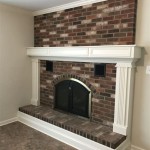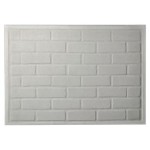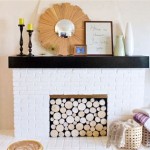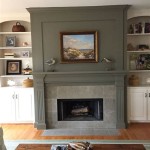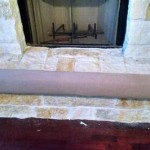Antique Iron Fireplace Surrounds: A History and Guide
Antique iron fireplace surrounds are more than just decorative elements; they are tangible pieces of history, reflecting craftsmanship, design trends, and societal values of past eras. These surrounds, typically crafted from cast iron, wrought iron, or a combination of both, served a functional purpose while also adding a significant aesthetic element to homes. Understanding their history, identifying different styles, and appreciating their value requires a nuanced knowledge of metalworking techniques and historical design influences.
The fireplace, for centuries, was the heart of the home, providing warmth, light, and a central gathering place. Early fireplaces were simple affairs, often just a hole in the wall. As architecture and social customs evolved, so did the fireplace. The addition of a surround, or mantelpiece, marked a significant development, elevating the fireplace from a purely utilitarian feature to a focal point of the room. This decorative element provided an opportunity to showcase wealth, taste, and artistic sensibilities.
Iron, due to its durability and ability to be molded into intricate designs, became a popular material for fireplace surrounds. The use of iron allowed for mass production while still retaining a certain level of artistic detail. Cast iron, in particular, enabled the creation of complex patterns and elaborate motifs, often inspired by classical mythology, nature, or geometric designs. Wrought iron, on the other hand, lent itself to more architectural and linear designs, often used for framing and structural support within the surround.
The Evolution of Iron Fireplace Surround Styles
The styles of antique iron fireplace surrounds evolved in tandem with architectural trends. Different historical periods produced distinct design characteristics, reflecting the prevailing aesthetic sensibilities of the time. These variations in style allow for a period-appropriate restoration or a carefully curated juxtaposition of styles within a modern interior.
During the Georgian era (1714-1830), fireplace surrounds often featured symmetrical designs, classical motifs, and restrained ornamentation. Common elements included fluted columns, dentil molding, and representations of urns, swags, and acanthus leaves. The overall effect was one of elegance and refinement, reflecting the aristocratic tastes of the period. Iron was typically used as a secondary material, often combined with marble or stone to create a more substantial and impressive architectural feature.
The Victorian era (1837-1901) witnessed an explosion of ornamentation and eclecticism in fireplace design. Mass production techniques allowed for more elaborate and intricate patterns to be incorporated into cast iron surrounds. Gothic Revival, Renaissance Revival, and Aesthetic Movement influences were all prevalent. Common motifs included floral patterns, geometric shapes, and depictions of animals. The use of color also became more common, with painted or enameled finishes adding visual interest to the ironwork. The Victorian fireplace surround served as a statement piece, reflecting the homeowner's status and taste.
The Art Nouveau period (roughly 1890-1910) brought a radical departure from the historical styles of the Victorian era. Art Nouveau fireplace surrounds were characterized by flowing lines, organic forms, and depictions of nature. Irises, lilies, and other floral motifs were common, as were stylized representations of insects and animals. The emphasis was on asymmetrical designs and a sense of movement. Ironwork was often combined with other materials, such as glass or tile, to create a more harmonious and integrated design.
The Art Deco period (1920s-1930s) embraced geometric shapes, streamlined forms, and industrial materials. Art Deco fireplace surrounds often featured symmetrical designs, bold colors, and stylized representations of modern technology. The use of angular shapes, zigzags, and stepped patterns was common. Iron was often combined with chrome or other metals to create a sleek and sophisticated look. The Art Deco fireplace surround reflected the era's fascination with speed, progress, and modernity.
Identifying Authentic Antique Iron Fireplace Surrounds
Determining the authenticity and age of an antique iron fireplace surround requires careful examination and attention to detail. Several factors can help to distinguish genuine antiques from reproductions or later imitations. These include the material composition, construction techniques, design features, and presence of markings or stamps.
The type of iron used can provide clues about the age and origin of the surround. Cast iron, with its ability to be molded into complex shapes, was widely used throughout the 19th and early 20th centuries. Wrought iron, with its more handcrafted appearance, was more common in earlier periods. The presence of impurities or slag within the iron can also indicate its age. Examining the surface texture and patina can also provide insights into the manufacturing process and the surround's history.
Construction techniques can also be revealing. Hand-forged elements, such as rivets and joints, are indicative of earlier craftsmanship. The presence of machine-made components may suggest a later date of manufacture. Examining the back of the surround can reveal how the various pieces were assembled and whether any modifications or repairs have been made over time. The quality of the casting or forging is also an important indicator of its original craftsmanship and value.
Design features, such as the style of ornamentation, the proportions of the surround, and the presence of specific motifs, can help to narrow down the period of origin. Consulting reference books, online resources, and antique dealers can provide valuable information about the characteristics of different period styles. Comparing the surround to known examples of similar designs can help to confirm its authenticity and age. Consider the level of detail and the execution of the design, as higher quality pieces often command a premium.
The presence of markings or stamps can provide valuable information about the manufacturer, the date of manufacture, or the country of origin. These markings are often found on the back of the surround or on the underside of the mantel. Researching these markings can help to identify the manufacturer and to verify the authenticity of the piece. However, it is important to note that the absence of markings does not necessarily mean that the surround is not authentic, as many smaller workshops did not regularly mark their products. Also, ensure any markings are consistent with the apparent age and style of the surround. A seemingly old surround with a modern manufacturer's mark should raise suspicion.
Restoration and Preservation of Antique Iron Fireplace Surrounds
Antique iron fireplace surrounds, due to their age and exposure to heat and moisture, often require some degree of restoration. The goal of restoration should be to preserve the original character and integrity of the piece while also ensuring its structural stability and aesthetic appeal. Proper restoration techniques can prolong the life of the surround and enhance its value.
Before undertaking any restoration work, it is important to assess the condition of the surround and to identify any areas of damage or deterioration. Common problems include rust, corrosion, cracks, and missing pieces. A thorough cleaning is essential to remove dirt, grime, and loose rust. Gentle cleaning methods, such as using a soft brush and mild soap, should be employed to avoid damaging the surface. Avoid harsh chemicals or abrasive cleaners, as these can strip away the original patina and damage the iron.
Rust removal is often a necessary step in the restoration process. There are several methods that can be used, including mechanical abrasion, chemical treatments, and electrolytic rust removal. Mechanical abrasion involves using a wire brush or sandpaper to remove rust. Chemical treatments involve applying a rust-removing solution to the surface. Electrolytic rust removal involves using an electric current to remove rust. The choice of method will depend on the severity of the rust and the condition of the iron. Care should be taken to avoid removing too much material or damaging the underlying surface.
Cracks and fractures can be repaired by welding or brazing. Welding involves using heat to fuse the broken pieces together. Brazing involves using a filler metal to join the pieces. A skilled metalworker should be employed to ensure that the repairs are done properly and that the welds are strong and durable. The welds should be carefully ground and smoothed to blend in with the surrounding surface. Consider consulting a specialist in antique iron restoration for complex or significant repairs.
Missing pieces can be replaced with new castings or fabrications. The new pieces should be made from the same type of iron as the original and should be designed to match the original in style and detail. A mold can be made from an existing piece to create a new casting. Alternatively, a metalworker can fabricate a new piece by hand. The new pieces should be carefully fitted and finished to blend in with the surrounding surface. It is generally best practice that replacement pieces are clearly identifiable (e.g., subtly marked on the back) to distinguish them from the original components during future valuations.
Once the repairs are complete, the surround should be protected with a suitable finish. Traditional finishes include black paint, wax, and linseed oil. Black paint provides a durable and protective coating. Wax provides a natural and lustrous finish. Linseed oil provides a protective coating that enhances the natural color of the iron. The choice of finish will depend on the desired aesthetic and the intended use of the surround. Before applying any finish, the surface should be thoroughly cleaned and prepared. Several coats of finish may be required to achieve the desired level of protection and appearance.
Proper maintenance is essential to prolonging the life of an antique iron fireplace surround. Regular cleaning and waxing can help to prevent rust and corrosion. Avoid exposing the surround to excessive moisture or heat. If the surround is not in use, it should be covered to protect it from dust and damage. With proper care and attention, an antique iron fireplace surround can be enjoyed for generations to come.

Late Victorian Cast Iron Fire Surround 4596cs Antique Fireplace Co

Cast Iron Mantels Surrounds Scarlett Fireplaces

Antique Metal Fireplace Surround Cast Iron

Buy Antique Neo Classical 19th Century Cast Iron Fireplace Surround

Buy Antique Late Victorian Early Edwardian Cast Iron Fire Surround

Victorian Cast Iron Fire Surround 4365cs Antique Fireplace Co

Victorian Cast Iron Fireplace Surround Chester Paint Stripping

Gallery Palmerston Cast Iron Fireplace Sovereign Flames Co

Reclaimed Antique Cast Iron Bedroom Fireplace Surround E A Reclamation

Torch Cast Iron Fireplace Surround
Related Posts

